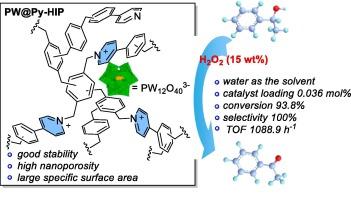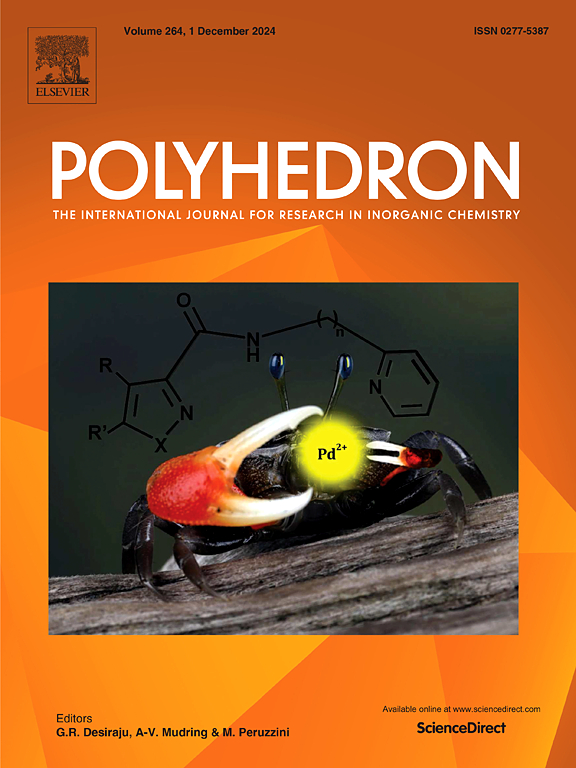Oxidation of alcohols to carbonyl compounds with H2O2 in water catalyzed by polyoxometalate-based hyper-crosslinked ionic polymer
IF 2.4
3区 化学
Q2 CHEMISTRY, INORGANIC & NUCLEAR
引用次数: 0
Abstract
The oxidation reaction involving hydrogen peroxide (H2O2) in water is of great attraction in fundamental research and industrial application, but there is still a long way to go. Herein, a new hybrid catalyst PW@Py-HIP was successfully synthesized by immobilization of phosphotungstic anions onto/into the pyridinium-based hyper-crosslinked ionic polymer using a post-synthetic strategy. This facile synthetic method afforded heterogeneous catalyst with a large specific surface area of 428.7 m2·g−1 and stable polymeric skeleton. The amphiphilic PW@Py-HIP exhibited remarkable catalytic activity and quantitative selectivity for the oxidation of alcohols into carbonyl compounds with H2O2 in water. The turnover frequency (TOF) and turnover number (TON) values reached 1088.9 h−1 and 4083.3, respectively. Owing to its good heterogeneous nature, PW@Py-HIP can be recycled for six times without significant loss of activity. The developed catalytic system confirmed to be beneficial toward the synthesis of related carbonyl compounds from various alcohols with appreciable conversions.

聚氧化金属基超交联离子聚合物催化水中 H2O2 将醇氧化为羰基化合物
过氧化氢(H2O2)在水中的氧化反应在基础研究和工业应用方面具有极大的吸引力,但仍有很长的路要走。本文采用后合成策略,将磷钨酸阴离子固定在吡啶基超交联离子聚合物上/内,成功合成了新型杂化催化剂 PW@Py-HIP。这种简便的合成方法得到了具有 428.7 m2-g-1 大比表面积和稳定聚合物骨架的异相催化剂。两亲性 PW@Py-HIP 在水中用 H2O2 将醇氧化成羰基化合物的过程中表现出显著的催化活性和定量选择性。其翻转频率(TOF)和翻转次数(TON)值分别达到了 1088.9 h-1 和 4083.3。由于具有良好的异质性,PW@Py-HIP 可以循环使用六次而不会明显丧失活性。经证实,所开发的催化系统有利于从各种醇合成相关的羰基化合物,且转化率可观。
本文章由计算机程序翻译,如有差异,请以英文原文为准。
求助全文
约1分钟内获得全文
求助全文
来源期刊

Polyhedron
化学-晶体学
CiteScore
4.90
自引率
7.70%
发文量
515
审稿时长
2 months
期刊介绍:
Polyhedron publishes original, fundamental, experimental and theoretical work of the highest quality in all the major areas of inorganic chemistry. This includes synthetic chemistry, coordination chemistry, organometallic chemistry, bioinorganic chemistry, and solid-state and materials chemistry.
Papers should be significant pieces of work, and all new compounds must be appropriately characterized. The inclusion of single-crystal X-ray structural data is strongly encouraged, but papers reporting only the X-ray structure determination of a single compound will usually not be considered. Papers on solid-state or materials chemistry will be expected to have a significant molecular chemistry component (such as the synthesis and characterization of the molecular precursors and/or a systematic study of the use of different precursors or reaction conditions) or demonstrate a cutting-edge application (for example inorganic materials for energy applications). Papers dealing only with stability constants are not considered.
 求助内容:
求助内容: 应助结果提醒方式:
应助结果提醒方式:


